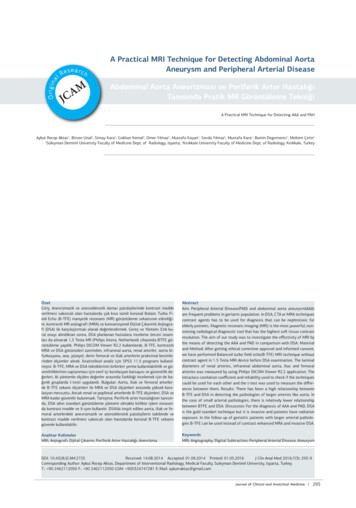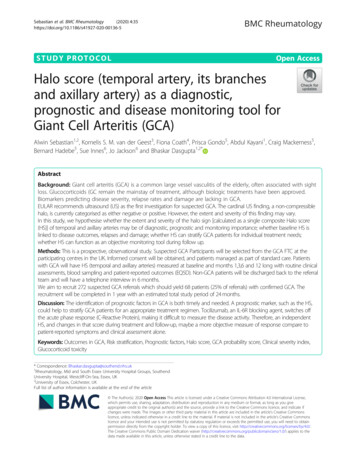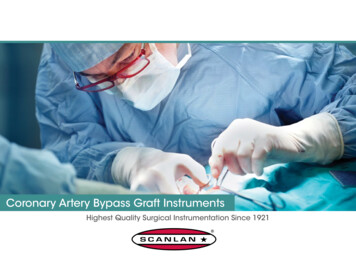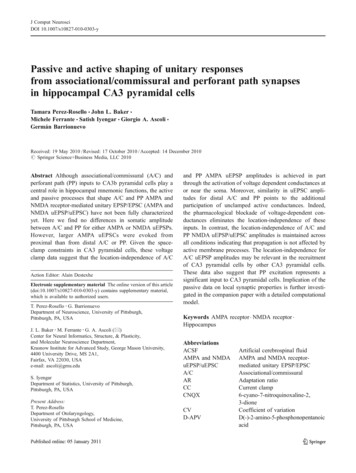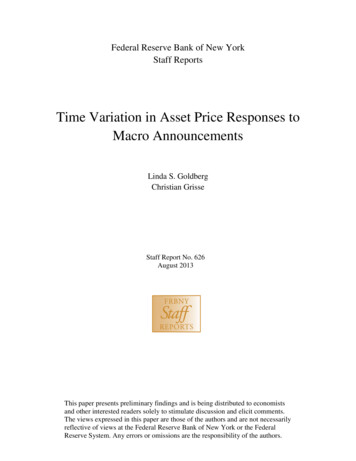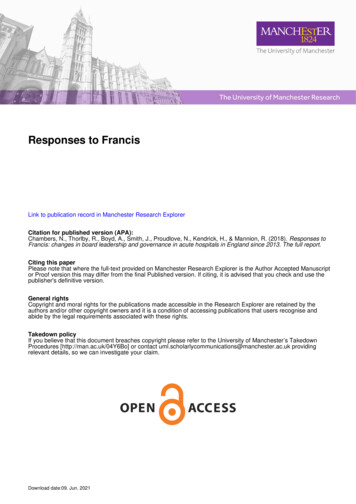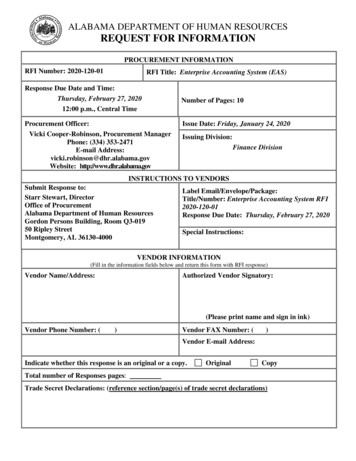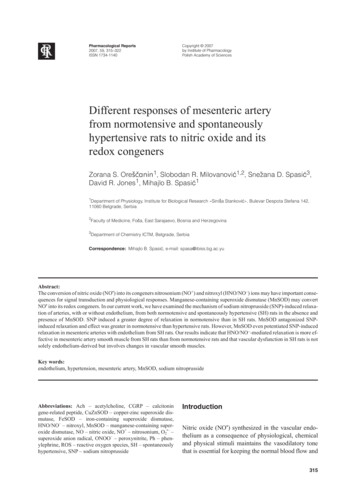
Transcription
Pharmacological ReportsCopyright 2007by Institute of PharmacologyPolish Academy of Sciences2007, 59, 315 322ISSN 1734-1140Different responses of mesenteric arteryfrom normotensive and spontaneouslyhypertensive rats to nitric oxide and itsredox congeners Zorana S. Orešcanin1, Slobodan R. Milovanoviæ1,2, Snezana D. Spasiæ3,David R. Jones1, Mihajlo B. Spasiæ1Department of Physiology, Institute for Biological Research «Siniša Stankoviæ», Bulevar Despota Stefana 142,11060 Belgrade, SerbiaFaculty of Medicine, Foèa, East Sarajaevo, Bosnia and Herzegovina!Department of Chemistry ICTM, Belgrade, SerbiaCorrespondence: Mihajlo B. Spasiæ, e-mail: spasa@ibiss.bg.ac.yuAbstract:The conversion of nitric oxide (NO ) into its congeners nitrosonium (NO ) and nitroxyl (HNO/NO ) ions may have important consequences for signal transduction and physiological responses. Manganese-containing superoxide dismutase (MnSOD) may convertNO into its redox congeners. In our current work, we have examined the mechanism of sodium nitroprusside (SNP)-induced relaxation of arteries, with or without endothelium, from both normotensive and spontaneously hypertensive (SH) rats in the absence andpresence of MnSOD. SNP induced a greater degree of relaxation in normotensive than in SH rats. MnSOD antagonized SNPinduced relaxation and effect was greater in normotensive than hypertensive rats. However, MnSOD even potentiated SNP-inducedrelaxation in mesenteric arteries with endothelium from SH rats. Our results indicate that HNO/NO -mediated relaxation is more effective in mesenteric artery smooth muscle from SH rats than from normotensive rats and that vascular dysfunction in SH rats is notsolely endothelium-derived but involves changes in vascular smooth muscles.Key words:endothelium, hypertension, mesenteric artery, MnSOD, sodium nitroprussideAbbreviations: Ach – acetylcholine, CGRP – calcitoningene-related peptide, CuZnSOD – copper-zinc superoxide dismutase, FeSOD – iron-containing superoxide dismutase,HNO/NO – nitroxyl, MnSOD – manganese-containing superoxide dismutase, NO – nitric oxide, NO – nitrosonium, O2 –superoxide anion radical, ONOO – peroxynitrite, Ph – phenylephrine, ROS – reactive oxygen species, SH – spontaneouslyhypertensive, SNP – sodium nitroprussideIntroductionNitric oxide (NO ) synthesized in the vascular endothelium as a consequence of physiological, chemicaland physical stimuli maintains the vasodilatory tonethat is essential for keeping the normal blood flow andPharmacological Reports, 2007, 59, 325 332315
arterial blood pressure, normal heart function, hemostasis and relaxation of vascular smooth muscle [16].The vascular endothelium is an important metabolicand endocrine organ that has an important role in homeostasis, vasorelaxation and, in some situations, hypertension. Endothelial dysfunction may be due toclassic risk factors and due to the presence of variousdiseases. In addition, the imbalance between production and/or degradation of NO and the superoxide anion radical (O2 –) is a cause of increased vascular resistance. The interaction between NO and O2 – radicals, that results in the formation of vasculotoxicperoxynitrite (ONOO–) and nitrosothiols, leads to destructive vicious cycles damaging the endotheliumand vascular smooth muscle cells [7]. Oxidative stressalters many functions of the endothelium includingmodulation of vasomotor tone. Inactivation of NO byO2 – and other reactive oxygen species (ROS) occursin such conditions as hypertension, hypercholesterolemia, diabetes and nicotine addition. Loss of NO associated with these traditional risk factors may in partexplain why it predisposes to atherosclerosis [4].The effect of SOD on the circulation and relaxationof smooth muscle has been studied [22, 24] from thepoint of view of SOD’s influence on the concentrationof O2 –, blockage of ONOO– production and extending the half-life of NO . MnSOD isolated from E. colihas been shown to possess the greatest anti-inflammatory activity in models, including adriamycininduced edema [8] and adjuvant-induced polyarthritis[9] when compared with SODs isolated from othersources. A possible explanation for such a differencecould be related to the fact that exposure of MnSODand FeSOD but not Cu/ZnSOD to NO leads to nitrosonium (NO ) and nitroxyl (HNO/NO–) generationcausing enzyme modification and inactivation [6, 19].The physiological effects of HNO/NO– are due to itsinteraction with endogenous neuropeptides such ascalcitonin gene-related peptide (CGRP). This 37-aminoacid peptide is the most potent vasodilator known todate and is thought to be involved in the regulation ofresting blood pressure and regional blood flow [13].Due to the direct connections between the biochemical and physiological actions of NO , HNO/NO– andNO , there are now new reasons to analyze the effectsof NO donors on important physiological functionssuch as artery relaxation. Taking into account thatCuZnSOD can react with NO– to generate NO [17]and that O2 – [24] and hydrogen peroxide (H2O2) can316Pharmacological Reports, 2007, 59, 325 332have a direct effect on smooth muscle [14, 18], a complex network of possible actions of these enzymes inblood vessels can be established. Due to the importantand discrete physiological roles of NO , HNO/NO–and NO , the analysis of the effects of SNP andMnSOD on arterial relaxation is an attractive topicworthy of study.Materials and MethodsArtery preparationsExperiments were performed using mesenteric arteries isolated from male Wistar and SH rats (250–300 g,6 months old). All protocols for handling the ratswere approved by the local ethics committee for animal experimentation that strictly followed international regulations. The adhering perivascular tissuewas carefully removed from arteries that were thencut into 3–5 mm ring segments and incubated for30 min in Krebs-Ringer bicarbonate solution at 36 Ccontinuously oxygenated with a mixture of 95% oxygen and 5% carbon dioxide. The rings were equilibrated for 30 min under 2 g of resting tension. An isometric transducer (Ugo Basile, 21025 Comerio, Italy)registered mechanical contractions. Contractions ofisolated blood vessels were provoked by phenylephrine (10–6 M) (Sigma-Aldrich, Taufkirchen, Germany) and the functional integrity of the endotheliumwas confirmed by acetylcholine (10–5 M) (Serva,Feinbiochemica Heidelberg, Germany) and by histopathological examination. The latter indicated that theendothelium was better preserved in normotensivethan in SH rats [14]. The percentage of relaxationcaused by acetylcholine depended on the degree ofendothelial preservation. In SH rats the endotheliumis continuously damaged due to high blood pressure,therefore, the relaxing effect of acetylcholine is muchlower than in normotensive rats [12].Increasing concentrations (10–10, 10–9, 10–8, 10–7,10–6, 10–5 M) of sodium nitroprusside (SNP) (Kemika, Zagreb, Croatia) were added to isolated mesenteric arteries of normotensive and SH rats which werepreviously contracted by phenylephrine (10–6 M). Thesame procedure was repeated in the presence of different concentrations (0.1, 1, 10, 100 mg/ml) ofMnSOD (isolated from E. coli by us) in the medium.
Influence of NO on mesenteric artery of normotensive and SH ratsZorana S. OreMnSOD was added to the medium 5 min before addingSNP. Acetylcholine, SNP, phenylephrine and all otherchemicals were used without additional purification.šèanin et al.tween different concentrations and multiple doseresponse curves, respectively.SOD isolation and enzyme assayMnSOD from E. coli was isolated according to Keele[11]. The activity of SOD was assayed using theadrenaline method [15].Statistical analysisAll data are expressed as the mean SEM and differences between groups were considered statisticallysignificant when p 0.05. One-way analysis of variance (ANOVA) followed by Dunnett’s test andNewman-Keuls’ test were used for comparisons be-ResultsThe effect of SNP on the relaxation of isolated mesenteric arteries from normotensive and SH rats with andwithout endothelium and the influence of MnSOD onthe relaxing effect of SNP was examined in all (4) experimental groups.SNP-mediated relaxation was stronger in normotensive compared to SH rats. SNP (10–5 M) caused 190%relaxation in the presence of the endothelium and325% relaxation without the endothelium (p 0.05)Fig . 1. (A) A representative recording of SNP-mediated relaxation of the mesenteric artery with endothelium (E ) isolated from normotensiverats, pre-contracted by phenylephrine (Ph), in the presence of different concentrations of MnSOD (E. coli) in the medium. (B) Dose-responsecurves for relaxation of rat mesenteric arteries of normotensive rat (E ) induced by increasing concentrations of SNP (10 , 10 ', 10 &, 10 %,10 , 10 # M) in the presence of different concentrations (0.1, 1, 10, 100 µg /ml) of MnSOD (E. coli) in the medium. Data are the mean SEM of6 experiments. * p 0.05 compared with control (k)Pharmacological Reports, 2007, 59, 325 332317
AAch – acetylcholinePh – phenylephrineSOD – superoxide dismutaseSNP – sodium nitroprussideW – washingB400*k350SOD 0.1 ìg/ml% relaxation*SOD 1.0 ìg/ml300SOD 10.0 ìg/mlSOD 100.0 ìg/ml250200*150100500-101234log{conc. SNP (nmol)}Fig. 2. (A) A representative recording of SNP-mediated relaxation of the mesenteric artery without endothelium (E-) isolated from normotensiverats, pre-contracted by phenylephrine (Ph), in the presence of different concentrations of MnSOD (E. coli) in the medium. (B) Dose-responsecurves for relaxation of rat mesenteric arteries of normotensive rat (E-) induced by increasing concentrations of SNP (10 , 10 ', 10 &, 10 %,10 , 10 # M) in the presence of different concentrations (0.1, 1, 10, 100 µg /ml) of MnSOD (E. coli) in the medium. Data are the mean SEM of6 experiments. * p 0.05 compared with control (k)in normotensive rats, and 35% relaxation in the presence of the endothelium and 135% relaxation withoutit (p 0.05) in SH rats. The percentage of relaxationwas greater than 100% because SNP is a strong vasodilator and causes relaxation that is below the basaltonus that is considered to be 100% relaxation. Therelaxing effect of SNP on the isolated mesenteric artery from normotensive rats was greater without endothelium (Fig. 1A, 2A), and was greater than in isolated mesenteric artery from SH rats (Fig. 3A, 4A).MnSOD exhibited a significant inhibitory effect onSNP-induced relaxation both in normotensive and SHrats except for mesenteric arteries from SH rats with318Pharmacological Reports, 2007, 59, 325 332endothelium where MnSOD potentiated SNP-inducedrelaxation (Fig. 3B).Figures 3B and 4B indicate that the inhibitory effect of MnSOD on relaxation induced by SNP wasless apparent in SH rats compared to normotensiverats. For example, the relaxing effect of SNP in normotensive rats was decreased 120% and 255% by thehighest concentration (100 mg/ml) of MnSOD in comparison with control (n 6, p 0.05) in the presenceand absence of endothelium, respectively. In SH rats,this inhibitory effect was 0–55% (n 6, p 0.05).MnSOD exhibited its strongest antagonistic effect inisolated mesenteric arteries without endothelium iso-
Influence of NO on mesenteric artery of normotensive and SH ratsZorana S. OreAšèanin et al.Ach – acetylcholinePh – phenylephrineSOD – superoxide dismutaseSNP – sodium nitroprussideW – washingBk250SOD 0.1 ìg/mlSOD 1.0 ìg/ml% relaxation200SOD 10.0 ìg/mlSOD 100.0 ìg/ml15010050*0-101234log{conc. SNP (nmol)}Fig. 3. (A) A representative recording of SNP-mediated relaxation of the mesenteric artery with endothelium (E ) isolated from SH rats, precontracted by phenylephrine (Ph), in the presence of different concentrations of MnSOD (E. coli) in the medium. (B) Dose-response curves for relaxation of rat mesenteric arteries of SH rat (E ) induced by increasing concentrations of SNP (10 , 10 ', 10 &, 10 %, 10 , 10 # M) in the presence of different concentrations (0.1, 1, 10, 100 µg /ml) of MnSOD (E. coli) in the medium. Data are the mean SEM of 6 experiments. * p 0.05compared with control (k)lated from normotensive rats (Fig. 1A). No such inhibitory effect of MnSOD was found in isolated mesenteric arteries with endothelium isolated from SHrats (Fig. 3A).DiscussionPrevious studies [21] have already established thatmesenteric arterial rings isolated from hypertensiverats show in vitro attenuated relaxation in response toSNP compared to rings from normotensive rats. However, those results suggest that the total functional capacity of vascular smooth muscle to relax in responseto nitrovasodilators is not changed with aging or hypertension. In some previously published experiments, we demonstrated that isolated arteries responded differently to NO and its redox congeners[12]. In our current work, we have tested the responseof mesenteric arteries isolated from normotensive ratsto SNP in the presence and absence of exogenouslyadded MnSOD. By conducting parallel experimentsusing the mesenteric artery isolated from SH rats, wewere able to perform full comparison.Pharmacological Reports, 2007, 59, 325 332319
AAch – acetylcholinePh – phenylephrineSOD – superoxide dismutaseSNP – sodium nitroprussideW – washingB175*k150SOD 0.1ìg/mlSOD 1.0 ìg/ml% relaxation125SOD 10.0 ìg/ml100*SOD 100.0 ìg/ml7550250-101234log{conc. SNP(nmol)}Fig. 4. (A) A representative recording of SNP-mediated relaxation of the mesenteric artery without endothelium (E-) isolated from SH rats, precontracted by phenylephrine (Ph), in the presence of different concentrations of MnSOD (E. coli) in the medium. (B) Dose-response curves forrelaxation of rat mesenteric arteries of SH rat (E-) induced by increasing concentrations of SNP (10 , 10 ', 10 &, 10 %, 10 , 10 # M) in the presence of different concentrations (0.1, 1, 10, 100 µg/ ml) of MnSOD (E. coli) in the medium. Data are the mean SEM of 6 experiments. * p 0.05compared with control (k)Herein we demonstrate a greater SNP-mediated relaxation of mesenteric arteries isolated from normotensive rats compared with that seen in mesentericarteries isolated from SH rats. Similar results wereobtained in experiments that involved SNP-mediatedrelaxation of isolated mesenteric arteries without endothelium. This indicated that besides the differencein the function of the endothelium, concerning basalNO production in normotensive and SH rats, a hypertension-induced difference existed in the smooth musclewith respect to NO -mediated relaxation. The application of SODs in medicine is based on its enzymaticactivity capable of eliminating O2 – and forming H2O2.One important effect of this enzyme is the protection320Pharmacological Reports, 2007, 59, 325 332against the breakdown of endothelium-derived vascular relaxation factor, NO . The pharmacological effects of various SODs have been examined [1] and theexperimental data indicate that, apart from their SODactivity, SODs have some direct pharmacological effects. Some tested doses of liposomal CuZnSODcaused a decrease (10–20 mmHg) in blood pressure.Higher concentrations of liposomal CuZnSOD causeda dose-dependent relaxation of the phenylephrinecontracted isolated inferior mesenteric artery. FreeCuZnSOD has been shown to cause a triphasic effecton blood pressure which may be explained by a mechanism that SOD supports a reversible reduction ofHNO to NO in addition to O2 – scavenging. Further-
Influence of NO on mesenteric artery of normotensive and SH ratsZorana S. Oremore, MnSOD was shown to directly interact withsmooth muscle and through non-specific reactionwith calcium channels to cause a mild relaxing effect[22]. Although all SODs are equal with respect toO2 – dismutation enzymatic activity [10], their differences in reaction with NO [19], indicate their differentbiological activity. Some authors [5] have used SODto study the participation of O2 – in the vasodilator response induced by SNP without specifying the exactnature of the SOD. One must realize that while testingthe effect of SOD on isolated smooth muscle onemust take into account SOD’s different reactivity towards NO .For this reason, we expected that in our experimentsusing isolated mesenteric arteries isolated from normotensive and SH rats, MnSOD would exaggerateSNP-mediated relaxation. However, our results indicated a significant inhibitory effect of MnSOD onSNP-mediated relaxation, except for mesenteric arteries containing endothelium isolated from SH rat, thatis in accordance with experiments performed byGrunfeld et al. [7]. The ability of SOD to decreaseO2 – and increase NO release was greater in SH ratscompared to normotensive rats.Another possible explanation of our results may bethat MnSOD converted NO into HNO/NO– and reduced cGMP-dependent relaxation. Therefore, cGMPindependent HNO/NO–-mediated relaxation may beoperative in vivo. It seems that this predominates inSH rats, compared with normotensive rats indicatingagain that vascular dysfunction in SH rats is not solelyendothelial-derived but involves other componentssuch as vascular smooth muscle. The generation ofNO and NO– ions by NO -treated MnSOD, whichproduces both enzyme modifications and inactivation,has been demonstrated [6, 19]. NO– is a redox-sensitive positive inotrope with selective vasodilatory action [20]. Furthermore, the differential chemical behavior of NO and NO– toward heme proteins offersthe unique control mechanism for the biological action of NO [23]. On the other hand, the diversephysiological responses observed following exposureof cells and/or isolated organs to NO and HNO/NO–donors suggest an intriguing and novel conditiondependent dimension to signal transduction and cellular regulation [18]. HNO/NO– induces CGRP releaseleading to the activation of CGRP receptors and subsequent cAMP-dependent smooth muscle relaxation[2, 3, 18].šèanin et al.In conclusion, our results demonstrated greaterSNP-mediated relaxation of mesenteric arteries fromnormotensive rats compared to SH rats. Similar results were obtained using isolated mesenteric arterieswithout endothelium, indicating that besides the difference in the function of endothelium, concerningbasal NO production in normotensive and SH rats,there is a distinction in the smooth muscle that is induced by hypertension with respect to NO relaxation.The presence of MnSOD in the Krebs-Ringer bicarbonate solution abrogated SNP-mediated relaxation inall the examined artery preparations except for themesenteric artery isolated from SH rats with endothelium, which shows that mechanisms of artery relaxation are different due to an endothelial and smoothmuscle changes in SH, as compared to normotensiverats. Our results clearly show that MnSOD, by modifying the chemical versatility of NO into redox activeforms, (NO and HNO/NO–), results in differential relaxing effects in the arteries of normotensive and SHrats (with or without the endothelium), suggesting thepossible role of HNO/NO–-induced relaxation in SHrats.Acknowledgments:This work was supported by a grant from the Ministry of Scienceand Environmental Protection of the Republic of Serbia, projectNo. 143034B “The role of redox-active substances in themaintenance of homeostasis”. This work is dedicated to the80th birthday of the British scientist Prof. A. Michael Michelson.References:1. Aleksiæ T, Jovoviæ Dj, Miloradoviæ Z, MihailoviæStanojeviæ N, Grujiæ-Milanoviæ J, Spasiæ M: Effects ofiron superoxide dismutase on haemodynamic parametersin spontaneously hypertensive rats. Acta Physiol Hung,2006, 93, 285–291.2. Bowe JE, Li XF, Kinsey-Jones JS, Paterson S, Brain SD,Lightman SL, O’Byrne KT: Calcitonin gene-relatedpeptide-induced suppression of luteinizing hormonepulses in the rat: the role of endogenous opioid peptides.J Physiol, 2005, 566, 921–928.3. Brain SD, Williams TJ, Tippins JR, Morris HR, MacIntyre I: Calcitonin gene-related peptide (CGRP) isa potent vasodilator. Nature, 1985, 313, 54–56.4. Cai H, Harrison DG: Endothelial dysfunction in cardiovascular diseases – the role of oxidant stress. Circ Res,2000, 87, 840–844.5. Ferrer M, Sanchez M, Minoves N, Salaices M, BalfagonG: Aging increases neuronal nitric oxide release andsuperoxide anion generation in mesenteric arteries fromPharmacological Reports, 2007, 59, 325 332321
6.7.8.9.10.11.12.13.14.15.322spontaneously hypertensive rats. J Vasc Res, 2003, 40,509–519.Filipoviæ M, Raièeviæ S, Spasiæ M and Niketiæ V:Consequences of MnSOD interactions with nitric oxide:nitric oxide dismutation, and the generation of peroxynitrite and hydrogen peroxide. Free Radic Res, 2007, 41,62–72.Grunfeld S, Hamilton CA, Mesaros S, McClain SW,Dominiczak AF, Bohr DF, Malinski T: Role of superoxide in the depressed nitric oxide production by the endothelium of genetically hypertensive rats. Hypertension,1995, 26(pt 1), 854–857.Jadot G, Michelson AM, Puget K: Anti-inflammatoryactivity of superoxide dismutases: inhibition of adriamycin induced edema in rats. Free Radic Res Commun,1986, 2, 19–26.Jadot G, Michelson AM, Puget K: Anti-inflammatoryactivity of superoxide dismutases: studies of adjuvantinduced polyarthritis in rats. Free Radic Res Commun,1986, 2, 27–42.Jones DR, Blagojeviæ D, Spasiæ MB: Once a scientist,always a scientist. A double anniversary for A. MichelMichelson in 2006: 80th birthday and 60 years in research. Biochimie, 2006, 88, 231–235.Keele BB Jr, McCord JM, Fridovich I: Superoxide dismutase from Escherichia coli B. A new manganesecontaining enzyme. J Biol Chem, 1970, 245, 6176–6181.Milovanoviæ SR, Orešèanin Z, Spasiæ S, Miletiæ S, Prostran M, Spasiæ MB: Effect of MnSOD (E. coli) on the relaxation caused by sodium nitroprusside on isolated ratrenal artery. J Serb Chem Soc, 2004, 69, 973–980.Miranda KM, Nims RW, Thomas DD, Espey MG,Citrin D, Bartberger MD, Paolocci N et al.: Comparisonof the reactivity of nitric oxide and nitroxyl with hemeproteins. A chemical discussion of the differential biological effects of these redox related products of NOS.J Inorg Biochem, 2003, 93, 52–60.Miranda KM: The chemistry of nitroxyl (HNO) and implications in biology. Coord Chem Rev, 2005, 249,433–455.Misra HP, Fridovich I: The role of superoxide anion inthe autoxidation of epinephrine and a simple assay forPharmacological Reports, 2007, 59, 325 33216.17.18.19.20.21.22.23.24.superoxide dismutase. J Biol Chem, 1972, 247,3170–3175.Moncada S, Palmer RMJ, Higgs EA: Nitric oxide: physiology, patophysiology and pharmacology. PharmacolRev, 1991, 43, 109–142.Murphy ME, Sies H: Reversible conversion of nitroxylanion to nitric oxide by superoxide dismutase. Proc NatlAcad Sci USA, 1991, 88, 10860–10864.Naghashpour M, Dahl G: Sensitivity of myometrium toCGRP varies during mouse estrous cycle and in responseto progesterone. Am J Physiol Cell Physiol, 2000, 278,C561–C569.Niketiæ V, Stojanoviæ S, Nikoliæ A, Spasiæ MB, Michelson AM: Exposure of Mn and FeSODs, but notCu/ZnSOD, to NO leads to nitrosonium and nitroxyl ionsgeneration which cause enzyme modification and inactivation: an in vitro study. Free Radic Biol Med, 1999, 27,992–996.Shew RL, Papka RE, McNeill DL, Yee JA: NADPHdiaphorase-positive nerves and the role of nitric oxide inCGRP relaxation of uterine contraction. Peptides, 1993,14, 637–641.Shirasaki Y, Su C, Lee TJ, Kolm P, Cline WH Jr,Nickols GA: Endothelial modulation of vascular relaxation to nitrovasodilators in aging and hypertension.J Pharmacol Exp Ther, 1986, 239, 861–866.Spasic M, Milovanovic M, Simovic M, Petrovic VM,Michelson AM: The effect of superoxide dismutase onisolated smooth muscle of the rat. In: Anticancerogenesisand Radiation Protection 2. Ed. Nygaard OF, Upton AC,Plenum Press, New York, London, 1991, 345–349.Tritthart HA, Mahnert W, Fleischhacker A, AdelwohrerN: Potassium channels and modulating factors of channel functions in the human myometrium. Z Kardiol,1991, 80, 29–33.Wang HD, Pagano PJ, Du Y, Cayate AJ, Quinn MT,Brecher P, Cochen RA et al.: Superoxide anion from adventia of the rat thoracic aorta inactivates nitric oxide.Circ Res, 1998, 82, 810–818.Received:December 6, 2006; in revised form: June 19, 2007.
Different responses of mesenteric artery from normotensive and spontaneously hypertensive rats to nitric oxide and its redox congeners Zorana S. Orešcanin1, Slobodan R. Milovanoviæ1,2, Snezana D. Spasiæ3, David R. Jones1, Mihajlo B. Spasiæ1 Department of Physiology, Institute for Biological
